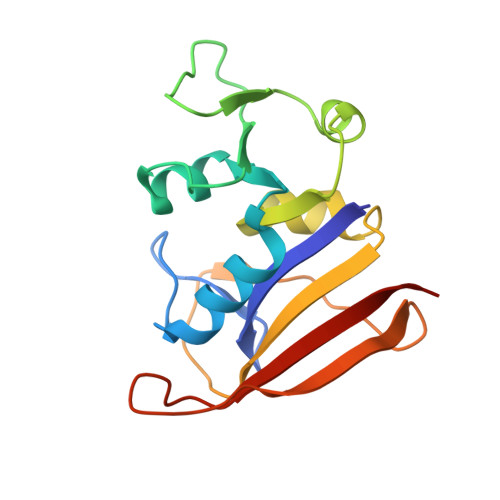Structural Comparison of Chromosomal and Exogenous Dihydrofolate Reductase from Staphylococcus Aureus in Complex with the Potent Inhibitor Trimethoprim.
Heaslet, H., Harris, M., Fahnoe, K., Sarver, R., Putz, H., Chang, J., Subramanian, C., Barreiro, G., Miller, J.R.(2009) Proteins 76: 706
- PubMed: 19280600
- DOI: https://doi.org/10.1002/prot.22383
- Primary Citation of Related Structures:
2W9G, 2W9H, 2W9S, 2W9T - PubMed Abstract:
Dihydrofolate reductase (DHFR) is the enzyme responsible for the NADPH-dependent reduction of 5,6-dihydrofolate to 5,6,7,8-tetrahydrofolate, an essential cofactor in the synthesis of purines, thymidylate, methionine, and other key metabolites. Because of its importance in multiple cellular functions, DHFR has been the subject of much research targeting the enzyme with anticancer, antibacterial, and antimicrobial agents. Clinically used compounds targeting DHFR include methotrexate for the treatment of cancer and diaminopyrimidines (DAPs) such as trimethoprim (TMP) for the treatment of bacterial infections. DAP inhibitors of DHFR have been used clinically for >30 years and resistance to these agents has become widespread. Methicillin-resistant Staphylococcus aureus (MRSA), the causative agent of many serious nosocomial and community acquired infections, and other gram-positive organisms can show resistance to DAPs through mutation of the chromosomal gene or acquisition of an alternative DHFR termed "S1 DHFR." To develop new therapies for health threats such as MRSA, it is important to understand the molecular basis of DAP resistance. Here, we report the crystal structure of the wild-type chromosomal DHFR from S. aureus in complex with NADPH and TMP. We have also solved the structure of the exogenous, TMP resistant S1 DHFR, apo and in complex with TMP. The structural and thermodynamic data point to important molecular differences between the two enzymes that lead to dramatically reduced affinity of DAPs to S1 DHFR. These differences in enzyme binding affinity translate into reduced antibacterial activity against strains of S. aureus that express S1 DHFR.
Organizational Affiliation:
Lead Development Technologies, Pfizer Global Research and Development, Groton, Connecticut 06340, USA. holly.h.soutter@pfizer.com

















